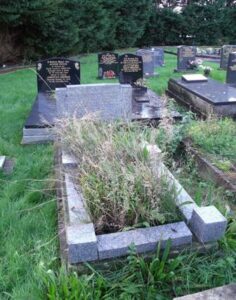Pontyates is a sprawling village which runs across both sides of the Gwendraeth Valley, mid-way between Carmarthen and Llanelli, on the B4309. The men of Pontyates who fell during both World Wars are commemorated on the village War Memorial, in the form of a red granite obelisk, which is situated in the floor of the valley, outside Pontyates Welfare Hall.
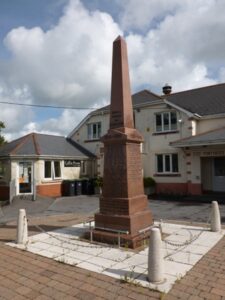
The Great War, 1914-1918
Harry Alexander, Private, 11081, Welsh Regiment. Harry was born at Whitechapel, but resided at Pontyates prior to the war. He enlisted at Carmarthen into the 2nd Battalion, the Welsh Regiment, which was sent to France at the outbreak of war as part of 3 Brigade, 1st Division. The Division moved immediately to the Belgian town of Mons, where they fought a pitched battle against the advancing Germans. The overwhelming attackers pushed the British southwards, through Le Cateau and down towards Paris, where the British stopped the German advance at the Battle of the Marne. The Germans retreated, and the BEF followed, fighting another Battle at the River Aisne, and it was here that Harry was wounded. He died just days later, on 18 September 1914. He is buried in a shared grave at Braine Communal Cemetery, France. Harry is not commemorated locally.
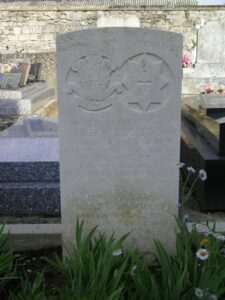
David Bennett, Private, 94375, Royal Welsh Fusiliers. David was born at Five Roads, the son of Elizabeth Bennett. His mother married Walter Worboy, of Avon View, Pontyates in 1905. David enlisted on 23 April 1917 and was called up early in 1918, joining the Monmouth Regiment at Cardiff. After training, David was posted to France on 23 October 1918, and was posted to the 14th Battalion, Royal Welsh Fusiliers, which was in France as part of 113 Brigade, 38th (Welsh) Division. The division had spent most of 1918 in positions around Aveluy Wood, near Albert on the Somme, and from there had begun the final drive to victory in August 1918. David joined them in October, when they were pushing towards the Forest of Mormal, and he was wounded soon afterwards, at the Battle of the Sambre, on 4 November 1918. Sadly David died just two days later. He is buried at Englefontaine British Cemetery, France.
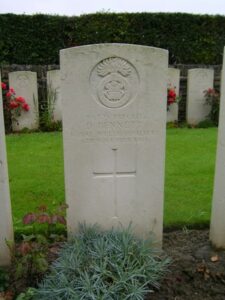
Richard Bowen, Sapper, 197432, Royal Engineers. Richard was the son of John and Mary Bowen, of Pontyates. He was educated at Cardiff and Aberystwyth, and worked as Assistant Master at Aber Council School, Ogmore Vale prior to the war. Richard joined the Royal Welsh Fusiliers soon after the outbreak of war, but then transferred to the 4th Special Brigade of the Royal Engineers, which was a Special (Gas) Company. Richard was wounded in France on 7 May 1917. He was brought back to Warrington Hospital, where he died of his wounds on 5 June 1917. Richard was 28 years old and was buried with full military honours at Pontyates Congregational Chapelyard.
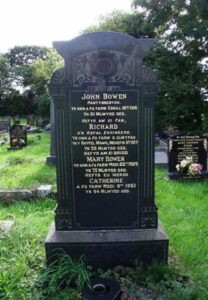
Cecil John Clark, Lance Corporal, 39436, Welsh Regiment. Cecil was the son of John and Albina Elizabeth Clark, of 111, Devon Road, Lower Easton, Easton, Bristol. He moved to Pontyates to live with his brother Sydney prior to the war and enlisted at Llanelli into the Welsh Regiment. Cecil originally landed in France on 2 December 1915 attached to one of the Welsh regiment battalions in the 38th (Welsh) Division, but must have been wounded at some time, then transferred to the 2nd Battalion, Welsh Regiment. The battalion was attached to 3 Brigade, 1st Division. The Division fought in Flanders before moving to the Somme in mid 1916, and it was here that Cecil was killed, during the Battle of Pozieres, on 26 July 1916, aged 20. He has no known grave, and is commemorated on the Thiepval Memorial, France. His brother Sydney also fell.
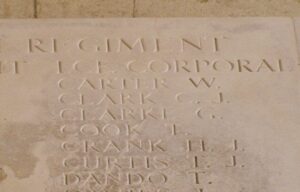
Sidney Herbert Clark, Private, S/4933, Black Watch. Sidney was the son of John and Albina Elizabeth Clark, of 111, Devon Road, Lower Easton, Easton, Bristol. He resided at Mon Terrace, Pontyates prior to the war and enlisted at Llanelli into the Army. Sidney was posted to the 9th Battalion, Black Watch, part of 44 Brigade, 15th (Scottish) Division. The division landed in France during July 1915, and would win regard by the enemy as one of the most formidable in the British Army. Here they fought at the Battle of Loos, and it was during the initial attack of 25 September 1915 that Sidney was killed. He was 29 years old and is buried at Philosophe British Cemetery, Mazingarbe, France. His brother Cecil also fell.
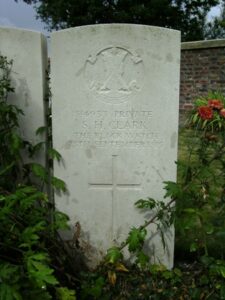
Onslow Davies, Gunner, 161163, Royal Garrison Artillery. Onslow was the son of Thomas and Elizabeth Anne Davies, of Ty Isaf, Pontyates. He enlisted at Llanelli into the Royal Garrison Artillery. He was posted to their 200th Siege Battery, which was in France from November 1916 onwards. Little else is known of Onslow, but he died aboard a ship in the Mediterranean on 31 December 1917, aged 20, and was buried at sea. He is commemorated on the Alexandria Chatby Memorial, Egypt.
William Davies, Private, 7976, Welsh Regiment. William was the son of Elias and Mary Davies, and was the Husband of Sarah Davies, of Llwyn-Teg, Pontyates. He was a regular soldier, serving with the 2nd Battalion, Welsh Regiment at the outbreak of war. The battalion was one of the first to move to France, attached to 3 Brigade, 1st Division, and moved to positions near Mons. It then fought at the Battle of Mons and at Le Cateau, then in the epic retreat south to the Marne, where the German offensive was held, before driving the Germans back north to the Aisne. The 1st Division was then sent to guard the eastern approach to Ypres, where it found itself in the centre of a fresh German offensive, aimed at cutting off the Channel Ports. William was killed here during the Battle of Gheluvelt on 29 October 1914. He was 28 years old, and is commemorated on Panel 37 of the Ypres (Menin Gate) Memorial, Belgium.
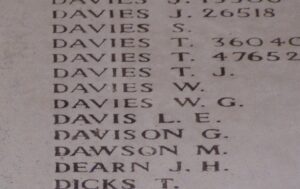
Alfred Elmore, Private, 10905, South Wales Borderers. Alfred was born at Stoke Newington, London, and was the brother of Henry (below). He was a regular soldier, serving with the 1st Battalion, South Wales Borderers, part of 3 Brigade, 1st Division, and he fought with them at the Battle of Mons and the retreat to the Marne. The battered Germans withdrew north towards the Valley of the Aisne, and the 1st Division met them in battle here again. It was here that Alfred was killed on 26 September 1914, aged 27. He has no known grave, and is commemorated on the La Ferté-Sous-Jouarre Memorial, France. His brother Henry also died. Alfred is not commemorated at Pontyates.
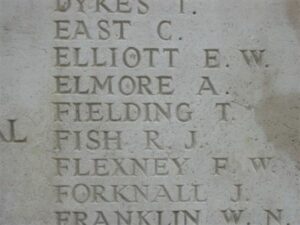
Henry Elmore, Private, 27829, Welsh Regiment. Henry was born at Marylebone, London, and resided at Pontyates prior to the war. He served with the 18th Battalion (2nd Glamorgan), Welsh Regiment, attached to 119 Brigade, 40th (Bantam) Division. This Division was formed between September and December 1915, composed of bantam units and others which had a mixture of regulation-height and shorter men. Weeding out of very under-sized or unfit men delayed the training programme, and it was not until late spring 1916 that the Division was ready to proceed on active service. The Division moved to France during June 1915, and moved to the front near Loos. Henry was killed soon after, on 2 August 1916, aged 23. He is buried at Maroc British Cemetery, Grenay, France. His brother Alfred also died, but is not commemorated on the Pontyates Memorial.
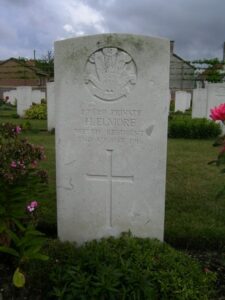
David Onslow Greville, 2nd Lieutenant, West Yorkshire Regiment. David was the son of David Thomas and Catherine Thomas (nee Greville), of Glangwendraeth, Pontyates. David was adopted by Thomas Greville, of Maes Derwen, Pontyberem a retired merchant who was Catherine’s brother. David was commissioned into the West Yorkshire Regiment, and posted to their 16th Battalion, which was attached to 93 Brigade, 31st Division. The Division had originally been moved to Egypt in December 1915 and then in March 1916 moved to the Western Front, where they took part in the opening of the Somme Offensive, during the Attack on Serre. They suffered terrible casualties here, and were withdrawn from the line for several months to rest and rebuild, before being moved into positions at Arras, where they took part in the Battle of the Scarpe, where David was killed in action on 3 May 1917. He was 24 years old, and is commemorated on the Arras Memorial, France.
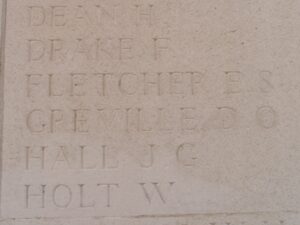
Tom Griffiths, Seaman, Deal/3464, Royal Marines. Tom was born on 12 August 1888, the son of Mary Griffiths, of Farmers Cottage, Llangendeirne. He married prior to the war, and lived with his wife Catherine Mary Griffiths; at Brongwendraeth House, Pontyates. (Catherine later lived at Rock House, Llanfynydd.) Tom was one of twelve Pontyates men who enlisted and served in the Royal Marines, attached to the 1st Field Ambulance, Medical Unit, 63rd (Royal Naval) Division. The Naval Brigades were originally sent to Antwerp and Dunkirk in September and October, 1914 to guard against invasion by the Germans. However Antwerp fell to the Germans soon after, and so many of the RND units were withdrawn to England. After a lengthy period of refit and training the Division moved to Egypt preparatory to the Gallipoli campaign. Landing on 25 April 1915 the Division fought throughout the Campaign on Gallipoli. Tom was wounded soon after, suffering a gun-shot wound to his abdomen, and was taken aboard His Majesty’s Hospital Ship Dongola for treatment. Sadly he died of his wounds on 4 May 1915, aged 26, and was buried at sea. Tom is commemorated on the Chatham Naval Memorial, Kent.
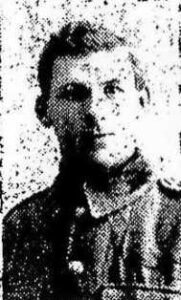
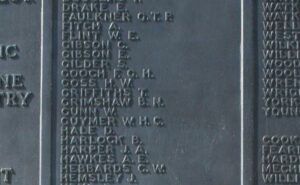
David Jones, Private, 20536, Welsh Regiment. David was born at Pontyates, and was the brother of Ebenezer Jones. He enlisted at Carmarthen into the locally raised 15th Battalion, Welsh Regiment, which was known as the Carmarthen Pals battalion. The battalion had trained at Rhyl and Winchester before moving to France in December 1915 attached to 114 Brigade, 38th (Welsh) Division. The division moved to the La Bassee area where they trained in trench warfare, and in June 1916 marched south to the Somme area, where it was tasked with the capture of Mametz Wood. The first attack went in on 7 July 1916 but was repulsed with heavy losses, and it was three days later that the attack was renewed, with a fresh assault going in at dawn on 10 July 1916. After two days of terrible hand to hand fighting, the wood was cleared, but at a terrible price, with the 38th Division suffering around 5,000 casualties, one of whom was David, who was killed on 11 July 1916. His grave was lost and he is now commemorated on the Thiepval Memorial, France. David is not commemorated at Pontyates.
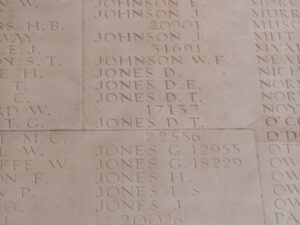
David Griffith Jones, Private, 46389, Lancashire Fusiliers. David was the son of Thomas and Catherine Jones, of Cwmbach, Pontyates, and enlisted at Carmarthen into the Middlesex Regiment. He subsequently transferred into the 10th Battalion, Lancashire Fusiliers, part of 52 Brigade, 17th (Northern) Division. During July 1915 the Division landed in France. They spent their initial period of trench familiarisation and then holding the front lines in the southern area of the Ypres salient. Here they took part in fighting at the Bluff during February 1916 before moving south, where they fought at the Battle of Albert, where the Division captured Fricourt at heavy cost during the opening of the Somme Offensive. They then saw action during the Battle of Arras, at the First and Second Battles of the Scarpe and the Capture of Rouex, before moving back to Ypres, and taking part in the First and Second Battles of Passchendaele. David was killed here on 9 November 1917. He was 23 years old and is commemorated on the Tyne Cot Memorial, Belgium.
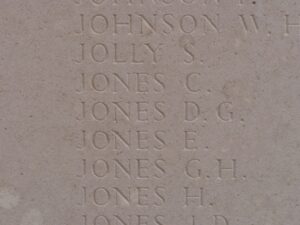
Ivor Idris Lewis, Private, 20853, Welsh Regiment. Ivor was the son of Theophilus and Catherine Lewis, of Rostella, Pontyates. He enlisted at Llanelli on 26 March 1915 into the Carmarthenshire Battalion, the 15th Battalion, Welsh Regiment. After training at Rhyl and Winchester, Ivor moved with the battalion to France in December 1915 as part of 114 Brigade, 38th (Welsh) Division. He survived the initiation into the trenches in Flanders, and the terrible fighting at Mametz Wood and in August 1916 moved with the division to positions north of Ypres, which they were to hold for the next year. On 31 August 1917 the 38th Division attacked the German positions on Pilckem Ridge, as part of the Battle of Third Ypres, and Ivor became wounded. He was evacuated to 32 Casualty Clearing Station at nearby Brandhoek for treatment, but sadly died of wounds there on 1 August 1917, aged 23. Ivor is buried at Brandhoek New Military Cemetery, Belgium.
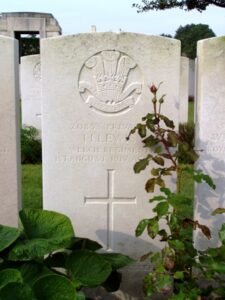
Martin Lloyd, Private, 61528, Royal Welsh Fusiliers. Martin was born at Llandyfeusant in 1889, the son of Henry and Rachel Lloyd, and was the Brother of Richard Lloyd, of Ardwyn, Cwmgwrach, Neath. Martin had enlisted at Carmarthen into the 14th Battalion, Royal Welsh Fusiliers, part of 113 Brigade, 38th (Welsh) Division. The Division had landed in France during December 1915 and had spent their first winter in the trenches near Armentieres. In June they marched south to the Somme, where they famously captured Mametz Wood. The Division suffered terrible casualties at Mametz, and were taken out of the line, and moved to Ypres to rebuild. Here they fought at the Battle of Pilckem Ridge, and the Battle of Langemarck. They then moved to Armentieres, where they remained until March 1918 when the German Spring Offensive was launched. The British had been over-run on the Somme, and so in April the Division was moved South, taking up positions North of Albert, from where they weathered the storm of the coming months. On 21 August 1918 the 38th Division launched their attack across the River Ancre, and began the drive towards the Hindenburg Line. Martin was killed near Delville Wood on 28 August 1918. He was 28 years old and is buried at Delville Wood Cemetery, Longueval. Martin is not on the memorial, but is named on the Carmarthen Roll of Honour as a Pontyates man.
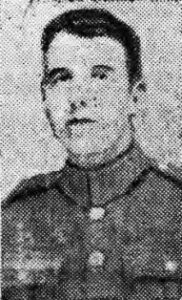
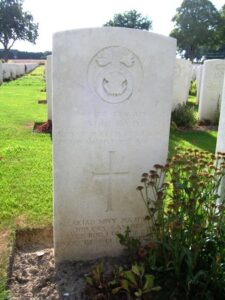
John Owens, Private, 45184, Royal Welsh Fusiliers. John was the son of David and Rachel Owens, of Llwynyrhebog Farm, Pontyates. He worked as a Draper in London prior to the war and enlisted at Camberwell on 12 December 1915 into the London Regiment. John was transferred to the Royal Welsh Fusiliers on 28 August 1916, and landed in France on 11 May 1917, joining the 2nd Battalion, Royal Welsh Fusiliers. The battalion had been in France since the outbreak of war, and had fought in most of the major actions since, being used as a stop-gap as part of 19 Brigade to fill in spaces in differing Divisions after heavy losses. By the summer of 1917, 19 Brigade was attached to 33rd Division, and took part in the Battle of Third Ypres, marching to front line positions at Stirling Castle, through Polygon Wood on the night of 25 September 1917. John was killed there, during the Battle of Polygon Wood, on 26 September 1917. He was 30 years old and is commemorated on the Tyne Cot Memorial, Belgium.
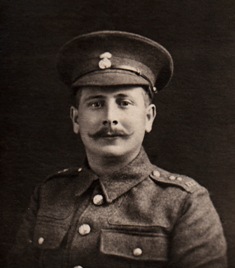
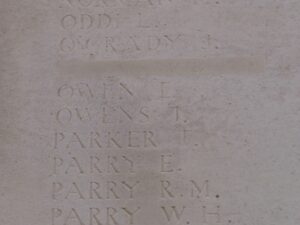
Evan Peter Rees, Private, 15981, Welsh Regiment. Evan was the son of Thomas and Betsy Rees, of Maes-y-bryn, Pontyates, and enlisted at Swansea into the 9th Battalion, Royal Welsh Fusiliers, which was attached to 58 Brigade, 19th (Western) Division. The Division assembled around Bulford during September 1914. Divisional training was completed near Tidworth, from March 1915, and the Division crossed to France during July 1915, and moved to positions near Loos. The Division fought during the opening attack of the Battle of Loos, which is when Evan was killed, on 25 September 1915. He was 23 years old, and as he has no known grave, is commemorated on the Loos Memorial, France.
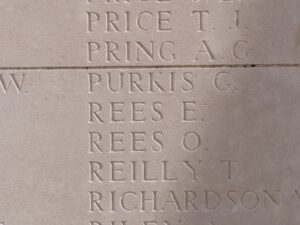
Astley John Onslow Thompson, VD, Lieutenant-Colonel, Australian Infantry. Astley was born near Pontypridd on 3 January 1865, the son of Astley and Udea Thompson. The family had resided at Llangendeirne for several years, before Astley emigrated to Australia, and had served for some years in the NSW Mounted Rifles, but had not fought in South Africa during the Boer War. Astley had managed the Camden Park Estate for many years, and despite being 49 years old at the outbreak of war, was seen as a man possessing the experience, drive and vitality required to raise, train and command the 4th Battalion, Australian Infantry, which was raised in New South Wales, and attached to 1st Brigade, 1st Australian Division. The battalion was raised within a fortnight of the declaration of war in August 1914, and embarked just two months later. After a brief stop in Albany, Western Australia, the battalion proceeded to Egypt, arriving on 2 December 1914. The battalion took part in the ANZAC landing on 25 April 1915 as part of the second and third waves, and pushed forward ahead of the neighbouring battalions, becoming isolated in a position known as Lone Pine. Astley was killed here that same day. He was 50 years old. His body was recovered weeks later and buried in the parapet of a trench, but he was later re-interred after the war at the 4th Battalion Parade Ground Cemetery, Gallipoli. Astley was Mentioned in Despatches by General Sir Ian Hamilton for his gallant conduct during the day of the landings. Astley is named on the County War Memorial roll, but is not on the Pontyates Memorial, although there is a private memorial to him in Pontyates Church.
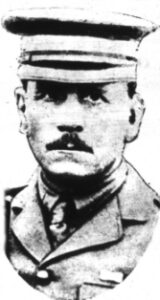
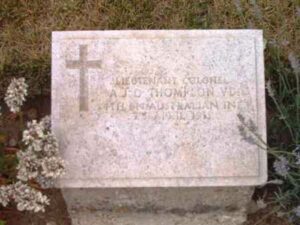
Robert Henry Williams, Private, 4470, Welsh Regiment. Robert was the son of William and Sarah Williams, of Moorland House, Pontyates, and had enlisted at Carmarthen into the local Territorial Battalion, the 1/4th Battalion, Welsh Regiment. The battalion formed part of 159 Brigade, 53rd (Welsh) Division, which moved to the Mediterranean, sailing from Devonport in July 1915 arriving at Mudros by the 5th August, 1915. From here they moved to Gallipoli, landing on 8 August 1915. The men were plunged straight into desperate fighting, and Robert was killed the following day, 10 August 1915. He was just 18 years old, and is buried at Green Hill Cemetery, Gallipoli.
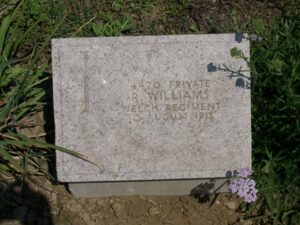
William Williams, Private, 4/13281, South Wales Borderers. William was the son of William and Mary Williams. He married prior to the war, and lived with his wife Annie Williams, at 75, Priory Glyn, Fach Farm, Pontyates. William enlisted at Tonyrefail into the 7th Battalion, South Wales Borderers, part of 67 Brigade, 22nd Division. The Division crossed to France in early September 1915, but it’s stay in France was very short, and on 27 October 1915 the Division began to embark for Salonika. It completed concentration there in November. It remained in the theatre for the rest of the war, taking part in the Retreat from Serbia during December 1915. During August 1916 they fought at the battle of Horseshoe Hill, then in September 1916 at the battle of Machukovo. During April to May 1917 the Division fought at the battle of Doiran. William was killed in Salonika on 9 November 1917. He was 25 years old, and is buried at Karasouli Military Cemetery, Greece.
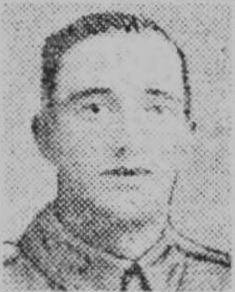
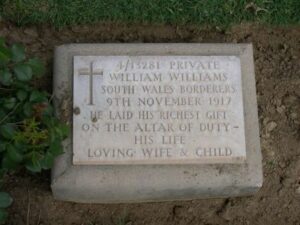
World War Two, 1939-1945
John Evans, Aircraftman 2nd Class, 1068014, Royal Air Force. Very little information can presently be found about John, but he served with the Royal Air Force, and died on active service on 23 May 1941, aged 20. He is commemorated on the Runnymede Memorial, Surrey.
Trefor Evans, Major, 149822, Parachute Regiment. Trefor was originally commissioned into the Royal Artillery, before joining the 6th (10th Bn. The Royal Welch Fusiliers) Battalion, Parachute Regiment. He was killed during the sinking of HMS Abdiel, at Taranto on 10 September 1943. Trefor is commemorated on the Cassino Memorial, Italy.
John Lewis James, Gunner, 1492795, Royal Artillery. John served with 7 Coast Regiment, Royal Artillery. The regiment formed part of the Singapore garrison, manning some of the coastal defence guns around the island. John was one of 80,000 men taken prisoner by the Japanese during the capitulation of Singapore on 15 February 1941, after a week of desperate fighting. He was sent to Thailand with ‘F’ Force in April 1943, and died at Kami Songkurai Camp of dysentery on 1 November 1943, aged 25. John was first buried at Kami Songkurai cemetery, but after the war, his grave was relocated to Thanbyuzayat War Cemetery, Myanmar.
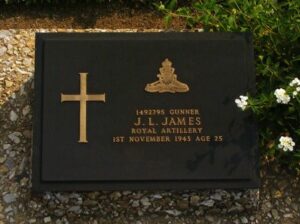
David John Jones, DFM, Pilot Officer, 129218, Royal Air Force Volunteer Reserve. David was born in 1920, the son of James Jones and Ellen Gwen Jones (nee Harries), of Bryn Llawddgar, Pontyates. His mother was from Llandyfaelog. After being educated at Carmarthen Grammar School, David enlisted into the Royal Air Force Volunteer Reserve, training as a Wireless Operator/ Air Gunner, before being posted to 12 Squadron, Royal Air Force, which was equipped with the Vickers Wellington III. On the evening of 28 August 1942, David took off from RAF Binbrook, aboard Vickers Wellington Z8656, which was part of a large formation sent to bomb strategic targets around Cassel, France. He was killed when his Wellington was shot down over Germany that night, 28 August 1942, with the loss of all her crew of five, three of whom were Welshmen. The 22-year-old is buried in Reichswald Forest War Cemetery, Germany. David was the holder of the Distinguished Flying Medal. He was a cousin to Daniel Evan Jenkins, who was also killed.
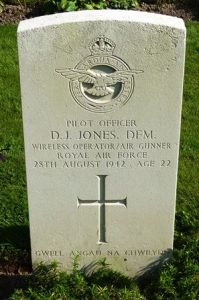
William Kerr Jones, Sergeant, 1310250, Royal Air Force Volunteer Reserve. William served as a Wireless Operator/ Air Gunner with 103 Squadron, Royal Air Force, which was a bomber squadron. During the start of the Second World War the Squadron made short-range day and night-bombing attacks with Fairey Battles, before re-equipping with Vickers Wellingtons, then Halifaxes and, finally the Avro Lancaster. William was killed along with all his crew, when their Lancaster was shot down over Germany on 31 May 1942. William was 29 years old when he died that day, and is buried alongside his former crew-members in Reichswald Forest War Cemetery, Germany.
Ernest John Lewis, Fusilier, 7046784, Royal Irish Fusiliers. Ernest was the son of Richard Tudor Lewis and Margaret Lewis of Pontyates, and the husband of Margaret Mary Hilda Lewis, of Handsworth, Birmingham. He served with the 1st Battalion, Royal Irish Fusiliers. The battalion served in the North African campaign, and after the fall of the Axis forces in Tunisia, took part in the invasion of Italy in 1943. Ernest was killed in Italy on 29 November 1943. He was 26 years old, and is buried in Sangro River War Cemetery, Italy.
Russell Veirian Rosser, DFM, Sergeant (Pilot), 1313694, Royal Air Force Volunteer Reserve. Russell was born on 30 May 1921, the son of David Rosser and Margaret Anne Rosser (nee Thomas), of Greenhill, Pontyates. After being educated at Carmarthen Grammar School, he found work as a Carpenter’s Mate, but left his job to enlist into the Royal Air Force Volunteer Reserve, and after qualifying as a pilot, was posted to 196 Squadron, Royal Air Force, which flew the Vickers Wellington X, based at RAF Leconfield. Russell was then attached to 466 (Royal Australian Air Force) Squadron at Leconfield. On 19 February his aircraft, Wellington HE-531, became the first aircraft in the squadron to shoot down a German night fighter which had damaged their Wellington. On 14 April 1943, Russell took off from Leconfield flying a Vickers Wellington X, Serial HE166 and took part in a raid on Stuttgart. The Wellington safely got back to England, landing at Tangmere on the following morning and Russell and his crew managed to snatch some sleep before taking off from Tangmere on the following day, 15 April 1943, to return to Leconfield. Tragically an engine cut out as the Wellington was starting to climb and the stricken aircraft plunged three miles west of the airfield, killing Russell and his crew of four. The remains of the 21-year-old were recovered from the wreckage, and he was brought home for burial in St. Mary’s Churchyard, Pontyates. He was the holder of the Distinguished Flying Medal.
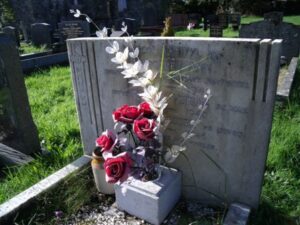
Daniel John Stuart, Fusilier, 4207969, Royal Welch Fusiliers. Daniel was the son of John Archibald and Mary Jane Stuart, of Pontyates. Very little is known of him, but he died on active service on 13 March 1941, aged 28, and is buried in Ponthenry Welsh Baptist Chapelyard.
